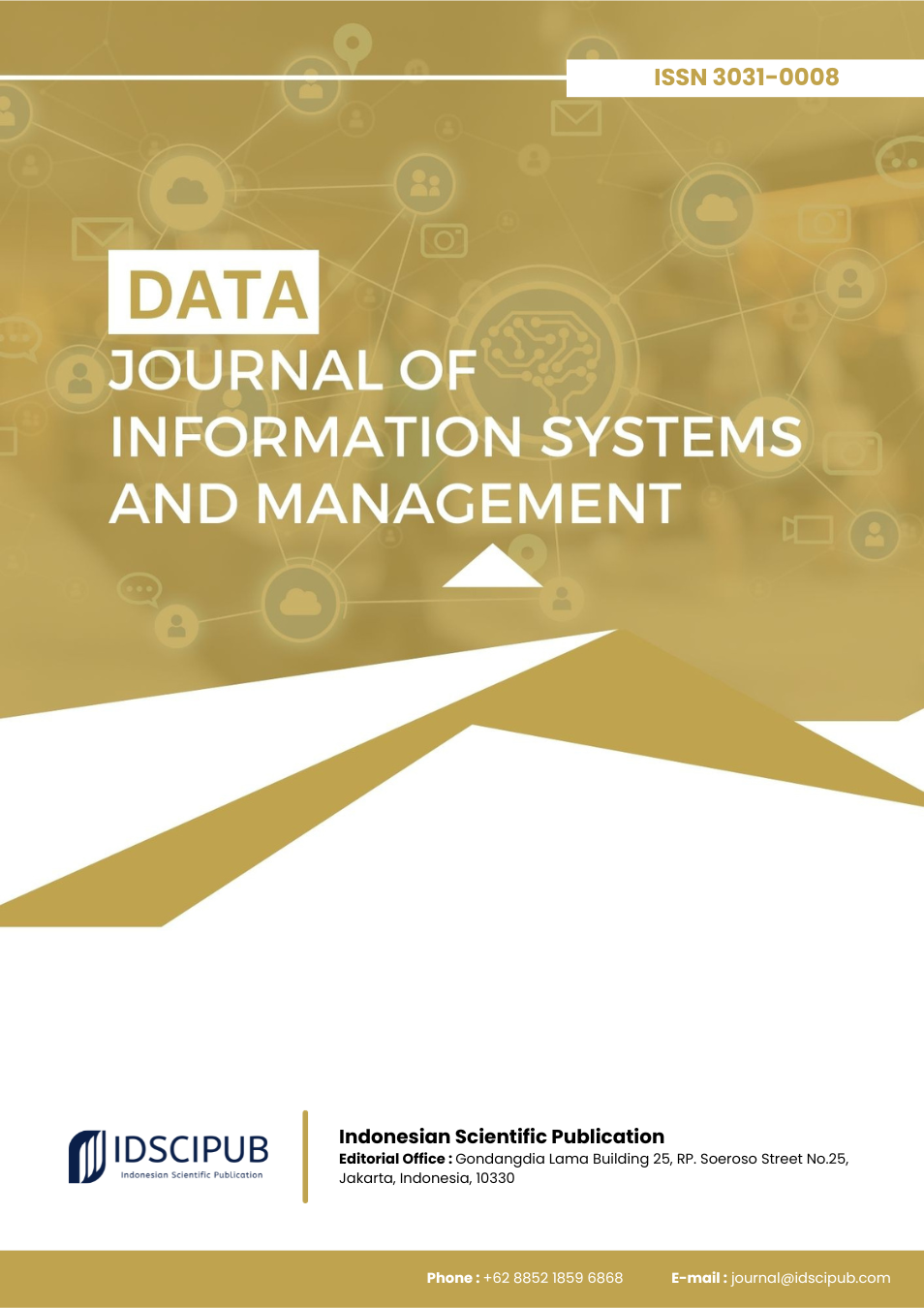Digital Meets Distribution: Quantifying the Impact of Logistics Integration in Emerging Market Omnichannel Retail
DOI:
https://doi.org/10.61978/data.v2i4.920Keywords:
Omnichannel Logistics, Service Level, Indonesia Retail, Distribution Centers, Click and Collect, Pay & Pick, Panel Data AnalysisAbstract
This study examines the impact of omnichannel logistics integration on retail service level performance in Indonesia between 2020 and 2024. Amidst rapid digital transformation in Southeast Asia, major Indonesian retailers such as AMRT, MIDI, MAPI, and LPPF have implemented innovations including store hubs, click-and-collect, and Pay & Pick services to meet evolving consumer expectations. Using firm-level quarterly panel data and employing fixed effects and event study models, the study analyzes how omnichannel logistics adoption represented by infrastructure investments and digital feature rollout affects service-level indicators such as inventory turnover, fill rate, and on-time delivery. The findings indicate that logistics integration significantly improves service metrics, with firms observing a 4–6% improvement in performance indicators within two quarters of implementation. This underscores the strategic value of aligning digital and physical infrastructure in emerging markets, offering evidence that logistics integration enhances both operational efficiency and service quality. The study contributes to both theoretical literature and practical retail strategies by framing omnichannel performance through a quantitative, data-driven lens.
References
Alikhani, R., Torabi, S. A., & Altay, N. (2021). Retail Supply Chain Network Design With Concurrent Resilience Capabilities. International Journal of Production Economics, 234, 108042. https://doi.org/10.1016/j.ijpe.2021.108042 DOI: https://doi.org/10.1016/j.ijpe.2021.108042
Athari, S. A., & Bahreini, M. (2022). Does Economic Policy Uncertainty Impact Firms’ Capital Structure Policy? Evidence From Western European Economies. Environmental Science and Pollution Research, 30(13), 37157–37173. https://doi.org/10.1007/s11356-022-24846-0 DOI: https://doi.org/10.1007/s11356-022-24846-0
Ayensa, E. J., Ana Mosquera de la Fuente, & Murillo, Y. S. (2016). Omnichannel Customer Behavior: Key Drivers of Technology Acceptance and Use and Their Effects on Purchase Intention. Frontiers in Psychology, 7. https://doi.org/10.3389/fpsyg.2016.01117 DOI: https://doi.org/10.3389/fpsyg.2016.01117
Buldeo, H., Verlinde, S., Macharis, C., Schoutteet, P., & Vanhaverbeke, L. (2019). Logistics Outsourcing in Omnichannel Retail. International Journal of Physical Distribution & Logistics Management, 49(3), 267–286. https://doi.org/10.1108/ijpdlm-02-2018-0092 DOI: https://doi.org/10.1108/IJPDLM-02-2018-0092
Eicker, T., & Cilliers, J. O. (2017). Equipping Small Business Retailers to Manage Logistical Supply Chain Drivers: A Theoretical Guideline. Journal of Transport and Supply Chain Management, 11. https://doi.org/10.4102/jtscm.v11i0.332 DOI: https://doi.org/10.4102/jtscm.v11i0.332
Faber, N., Koster, R. d., & Smidts, A. (2017). Survival of the Fittest: The Impact of Fit Between Warehouse Management Structure and Warehouse Context on Warehouse Performance. International Journal of Production Research, 56(1–2), 120–139. https://doi.org/10.1080/00207543.2017.1395489 DOI: https://doi.org/10.1080/00207543.2017.1395489
Haron, R., Nomran, N. M., Othman, A. H. A., Husin, M. M., & Sharofiddin, A. (2021). The Influence of Firm, Industry and Concentrated Ownership on Dynamic Capital Structure Decision in Emerging Market. Journal of Asia Business Studies, 15(5), 689–709. https://doi.org/10.1108/jabs-04-2019-0109 DOI: https://doi.org/10.1108/JABS-04-2019-0109
Iglesías-Pradas, S., & Acquila-Natale, E. (2023). The Future of E-Commerce: Overview and Prospects of Multichannel and Omnichannel Retail. Journal of Theoretical and Applied Electronic Commerce Research, 18(1), 656–667. https://doi.org/10.3390/jtaer18010033 DOI: https://doi.org/10.3390/jtaer18010033
Ishfaq, R., Darby, J. L., & Gibson, B. (2023). Adapting the Retail Business Model to Omnichannel Strategy: A Supply Chain Management Perspective. Journal of Business Logistics, 45(1). https://doi.org/10.1111/jbl.12352 DOI: https://doi.org/10.1111/jbl.12352
Ishfaq, R., & Raja, U. (2017). Evaluation of Order Fulfillment Options in Retail Supply Chains. Decision Sciences, 49(3), 487–521. https://doi.org/10.1111/deci.12277 DOI: https://doi.org/10.1111/deci.12277
Jaisinghani, D., Kaur, H., Goyal, J., & Joshi, M. (2019). Marketing Intensity and Persistence of Firm Performance: Empirical Evidence From Indonesia. International Journal of Productivity and Performance Management, 69(6), 1109–1127. https://doi.org/10.1108/ijppm-02-2019-0072 DOI: https://doi.org/10.1108/IJPPM-02-2019-0072
Lehrer, C., & Trenz, M. (2022). Omnichannel Business. Electronic Markets, 32(2), 687–699. https://doi.org/10.1007/s12525-021-00511-1 DOI: https://doi.org/10.1007/s12525-021-00511-1
Liu, Y., & Song, G. (2023). Role of Logistics Integration Capability in Enhancing Performance in Omni-Channel Retailing: Supply Chain Integration as Mediator. Sustainability, 15(11), 9053. https://doi.org/10.3390/su15119053 DOI: https://doi.org/10.3390/su15119053
Mahakitsiri, D., & Suwanprasert, W. (2022). Who Are Pure Exporters? World Economy, 46(6), 1759–1781. https://doi.org/10.1111/twec.13351 DOI: https://doi.org/10.1111/twec.13351
Mishra, R., Singh, R. K., & Köles, B. (2020). Consumer Decision‐making in Omnichannel Retailing: Literature Review and Future Research Agenda. International Journal of Consumer Studies, 45(2), 147–174. https://doi.org/10.1111/ijcs.12617 DOI: https://doi.org/10.1111/ijcs.12617
Mubarak, A., & Rahman, I. (2020). A Comparative Analysis of Carbon Emissions From Transportation and Logistics of the Consumer Goods Industry in Southeast Asia. International Journal of Technology, 11(2), 333. https://doi.org/10.14716/ijtech.v11i2.3466 DOI: https://doi.org/10.14716/ijtech.v11i2.3466
Mulya, A., Wibowo, S. A., & Purwanegara, M. S. (2023). Elevating Consumer Decision Journey to Increase Consumer Loyalty in Tokopedia and Shopee for PT. SNACK LEZAT Products. The Asian Journal of Technology Management (Ajtm), 16(3), 201–210. https://doi.org/10.12695/ajtm.2023.16.3.4 DOI: https://doi.org/10.12695/ajtm.2023.16.3.4
Murfield, M. L. U., Boone, C. A., Rutner, P., & Thomas, R. W. (2017). Investigating Logistics Service Quality in Omni-Channel Retailing. International Journal of Physical Distribution & Logistics Management, 47(4), 263–296. https://doi.org/10.1108/ijpdlm-06-2016-0161 DOI: https://doi.org/10.1108/IJPDLM-06-2016-0161
Nadeem, M., Gan, C., & Nguyen, C. (2017). Does Intellectual Capital Efficiency Improve Firm Performance in BRICS Economies? A Dynamic Panel Estimation. Measuring Business Excellence, 21(1), 65–85. https://doi.org/10.1108/mbe-12-2015-0055 DOI: https://doi.org/10.1108/MBE-12-2015-0055
Nailah, N., & Rusydiana, A. S. (2020). Efficiency and Stability of Islamic Banking in Asean: Dea Window Analysis. Tazkia Islamic Finance and Business Review, 14(1). https://doi.org/10.30993/tifbr.v14i1.211 DOI: https://doi.org/10.30993/tifbr.v14i1.211
Natarajan, T., Raghavan, D. R. V., & Jayapal, J. (2023). How Does Channel Integration Quality Promote Omnichannel Customer Citizenship Behavior? The Moderating Role of the Number of Channels Used and Gender. Kybernetes, 53(10), 3133–3159. https://doi.org/10.1108/k-11-2022-1594 DOI: https://doi.org/10.1108/K-11-2022-1594
Ryba, R. (2024). Evaluating the Economic Impacts of a Cage-Free Animal Welfare Policy in Southeast Asian and Indian Egg Production: A Systematic Review. Evaluation Review, 49(3), 564–593. https://doi.org/10.1177/0193841x241280681 DOI: https://doi.org/10.1177/0193841X241280681
Saghiri, S., Wilding, R., Mena, C., & Bourlakis, M. (2017). Toward a Three-Dimensional Framework for Omni-Channel. Journal of Business Research, 77, 53–67. https://doi.org/10.1016/j.jbusres.2017.03.025 DOI: https://doi.org/10.1016/j.jbusres.2017.03.025
Solem, B. A. A., Fredriksen, J. I., & Sørebø, Ø. (2022). Dynamic Capabilities in the Realisation of Omnichannel Retailing. International Journal of Retail & Distribution Management, 51(1), 21–38. https://doi.org/10.1108/ijrdm-12-2021-0599 DOI: https://doi.org/10.1108/IJRDM-12-2021-0599
Sousa, P. R. d., Barbosa, M. W., Oliveira, L. K. d., Paulo Tarso Vilela de Resende, Rodrigues, R. R., Moura, M. T., & Matoso, D. (2021). Challenges, Opportunities, and Lessons Learned: Sustainability in Brazilian Omnichannel Retail. Sustainability, 13(2), 666. https://doi.org/10.3390/su13020666 DOI: https://doi.org/10.3390/su13020666
Urbaitytė, V., & Ulbinaitė, A. (2020). Framework for Evaluating the Relationship Between the Omnichannel Online Sales Approach and Performance Outcome in the Case of Niche Products. https://doi.org/10.3846/bm.2020.563 DOI: https://doi.org/10.3846/bm.2020.563
Zhu, C., Husnain, M., Ullah, S., Khan, M. T., & Ali, W. (2022). Gender Diversity and Firms’ Sustainable Performance: Moderating Role of CEO Duality in Emerging Equity Market. Sustainability, 14(12), 7177. https://doi.org/10.3390/su14127177 DOI: https://doi.org/10.3390/su14127177






